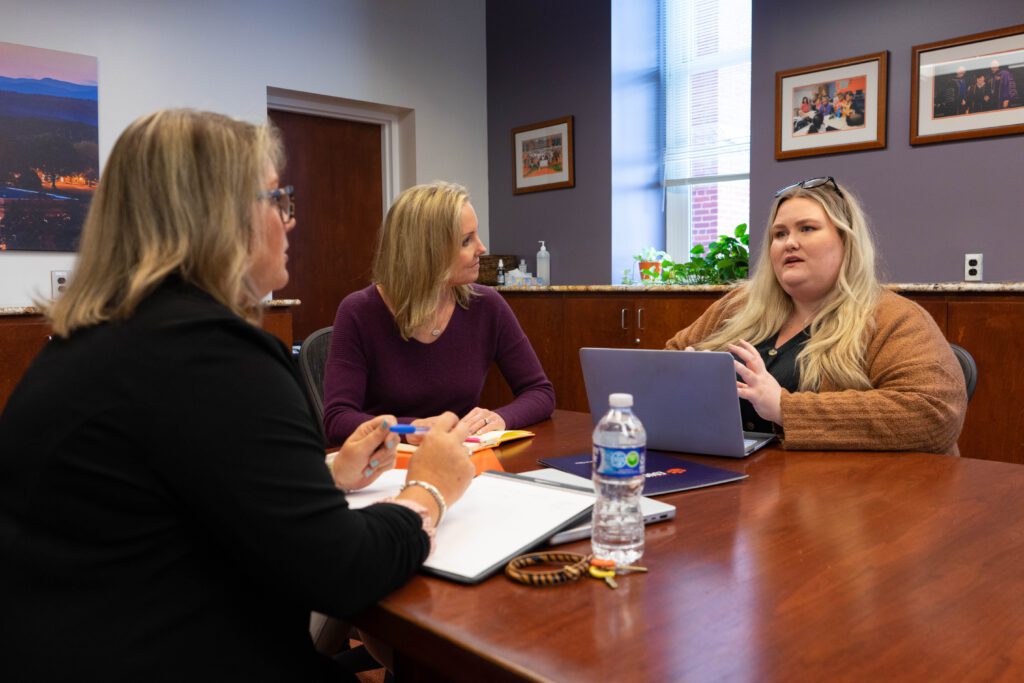“Broad” is a good starting point to describe the Clemson University College of Education’s Department of Teaching and Learning. Students in the department work to earn one of 10 different degrees that can place them in classrooms ranging from preschool to high school, and faculty work with undergraduate and graduate students in in-person, online and hybrid courses.
The department’s success hinges on faculty collaboration, and a trio of faculty members has had resounding success in teaching and working together to “read the pulse” of a diverse student body so they can respond to its needs both academically and personally.
Although Kirsten Abel exclusively teaches elementary education majors and Koti Hubbard and Jill Shelnut teach those majoring in early childhood education, their students often overlap due to course content. According to Abel, her collaboration with Hubbard and Shelnut allows all of them to gain insight into how to best serve specific students and the study body as a whole.
“We have many of the same students either year to year or at the same time, and because all three of us have full course loads, we can’t help but really get to know those students – we’re very much in their lives,” Abel said. “I think we’re able to lean on each other as educators and prescribe an approach that addresses issues related to student stress or well-being because we have our finger on that pulse.”
Abel and Hubbard are currently collaborating on a Creative Inquiry project in which they are working with students to review and evaluate quality literature for children. Students in the project work with Abel and Hubbard to write brief book reviews in Literacy Matters, the state journal of the Palmetto State Literacy Association. The student reviews help to inform the books’ use by pre-school-to-sixth-grade educators.

As two early childhood education lecturers, Hubbard said she and Shelnut problem-solve situations so frequently together that students have come to see them as a teaching team. Hubbard said Shelnut’s ability to build relationships has caused her to reflect and improve on how she forms connections with students.
Shelnut said Hubbard’s organizational skills are second to none, and Shelnut is always excited to hear Hubbard’s plan for courses and how she maintains the course materials that inspire much of her own teaching. Shelnut also enjoys the proximity to both lecturers; it is convenient to drop in on Abel and discuss topics related to the department or students. That proximity and camaraderie take Shelnut back to her college years.
“Being so close to one another allows for deeper conversations; it reminds me of standing in the doorway of my freshman dorms and making new friends,” Shelnut said. “Our students appreciate hearing that we all stay connected and talk on a daily basis. I truly believe that it strengthens our teaching and, possibly, students’ learning.”
Abel said these natural, authentic encounters naturally turn into discussions about students. That proximity has allowed them to help specific students in challenging situations directly.
A student who experienced a death in the family was experiencing understandable issues focusing on the course material. Office proximity allowed Hubbard and Abel to meet with the student together to show their support and connect them to campus resources.
A shared hallway offers convenience, but Hubbard said a shared philosophy truly guides their department and the College: when considering the student, consider the whole person. She said contemporary students have many demands on their time and mental health concerns on the best of days, so any circumstance – a family or health issue, for example – only makes their workload much heavier.
“I think Kirsten, Jill and I help each other find ways to provide a humanizing learning experience while still holding our students to high standards,” Hubbard said. “It is important that the three of us and our department consider the whole person because it is exactly how we tell our students to view their own students in the future.”
Get in touch and we will connect you with the author or another expert.
Or email us at news@clemson.edu

